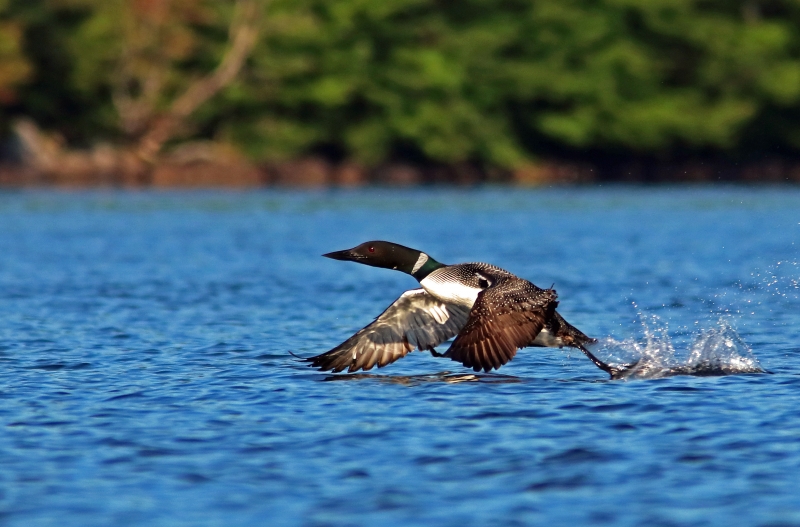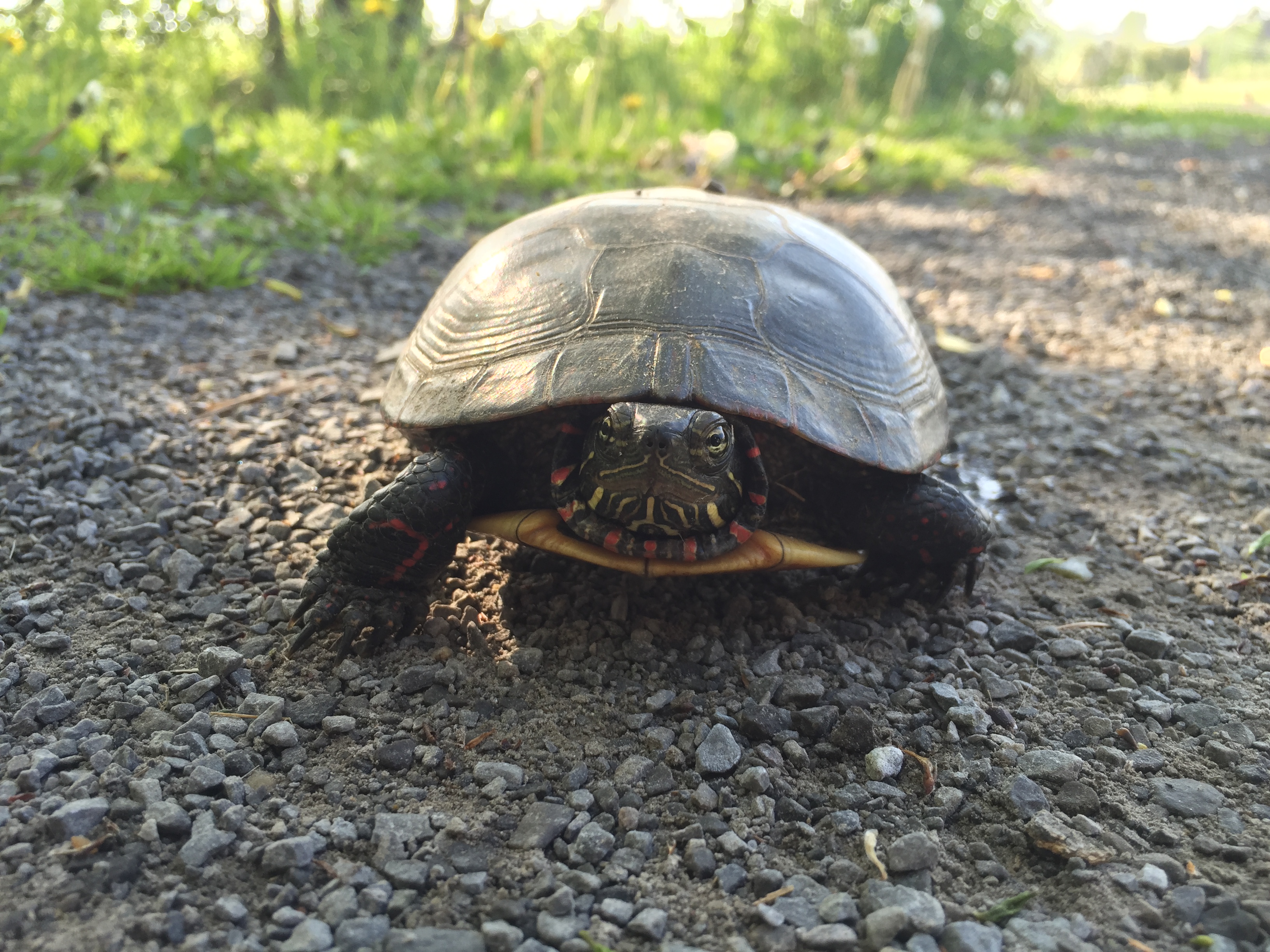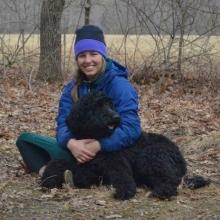
A loon takes off on Lake Ozonia. Loons require large bodies of open water to take flight. Photo: Joseph Woody
Winter Is Coming: A Tale of Three North Country Species
Come fall, we all start to prepare for winter in our own ways. We unearth the sweaters that have been accumulating dust since spring, and pull out our wool hats and mittens. Some of us chop wood and stack it next to the door, or restock the storm candles in the drawer by the stove. We can food, stocking pantry shelves with jars of red tomatoe sauce, purple sauerkraut, green dilly beans. There is a current running through the air, a rush to beat the cold. But we aren’t the only ones who are getting ready; lots of other North Country natives have their own survival plans.
Black bears rely on the strategy of ‘fattening up for winter’ – something I admit I am familiar with as well. It may sound like an excuse to pack on a couple of extra pounds, but if bears do it, it must be legit, right? Although bears are most highly concentrated in the Adirondacks – the region is home to nearly 4,000 – they are not confined to within the blue line and have been frequently encountered throughout the North Country.
Just like I do, black bears spend the fall storing their food – they just store it as fat instead of canning it and lining it up neatly in the pantry. Black bears don’t eat at all during their hibernation period, so they go through a period of ‘hyperphagia’, or overeating beforehand. Caloric consumption increases from 5,000 – 8,000 calories a day during spring and summer to 20,000 calories a day in order to prepare for the cold weather. That would be the equivalent of eating four times as much at each meal for us!
Nearly ninety percent of bears’ diets are made up of plants, so they spend September and October gorging themselves on ash berries, black cherries, hazelnuts, beechnuts, and acorns. On some of my own foraging walks through the forest in late fall, I’ve seen harsh claw marks along the smooth gray trunks of beech trees, evidence of the bears’ attempts at snacking.
Once a bear has found a plentiful spot, it can eat for twenty hours straight and stay there for days, until its harvest has been depleted. Hydration is key, too – one bear must drink gallons of water each day in order to purge itself of excess waste. The goal is to metabolize meals into fat and clean its body of anything else, so that its winter isn’t interrupted by bathroom breaks.

Black bear in Parishville. Photo: Carla Jean LaFave natureupnorth.org
By late October, the once bountiful food resources that sustain black bears have become scarce, and hibernation is their response. I have images in my mind of sleepy bears with pajamas and nightcaps from my childhood storybooks, but it turns out those weren’t a fully accurate depiction. While hibernation does take a form of dormancy for bears, it’s not exactly the deep, uninterrupted slumber in a bunk bed that I pictured. Instead, their bodies know to slow down; their resting heart rate reduces to barely ten beats a minute and they drop their body temperature by 12˚F.
By the time Thanksgiving rolls around, North Country black bears are breathing only once every forty-five seconds. They can still get up and walk around, but they don’t urinate or defecate until spring, and their movement is slow due to a reduction of muscular blood flow. An unseasonably warm day might prompt them to stick their heads out of their dens and enjoy the sunshine for a moment – I know I cherish those days as well – before returning to their dormancy.
In a way, black bears embody North Country winters; lots of food stored up, and time to slow down – it’s what many of us know well. But that’s not everyone’s strategy; some of us, including the common loon, prefer to pack our bags and head south to escape the icy weather.
During the summer, there are around 800 adult loons in New York State – many concentrated throughout the Adirondacks and North Country – but that number fluctuates with the seasons. Eight hundred may seem like a small population, and it is, especially in comparison to black bears (or mosquitos). The particular habitat that loons require to live is not as prevalent in the North Country as in other areas of the country, but their presence here has remained stable throughout the last decade.
A loon’s appearance is striking: its slick black head contrasts with the pattern of white checks that is displayed across its back, with watchful red eyes that seem wise and understanding. Many people consider the loon to be the ‘the spirit of the northern waters’, a symbol of unspoiled wilderness. That may be true, up until when the lakes freeze.
Loons diver for their meals, which most often consist of sunfish or bass. They prefer deep lakes, and can dive up to 200 feet for food. The vast open water also is necessary for social interactions, while the shallow edges around the shore provide ample opportunity for nesting and foraging. Their bodies are highly adapted for water -- on land, their short legs located far back on their bodies make walking awkward and slightly cumbersome.
Loons aren’t the most graceful fliers. Their heavy bodies and large feet make takeoff laborious; one loon might run across the water for a quarter of a mile to pick up the necessary speed before becoming airborne. Small lakes and ponds aren’t suitable – they need a surface area of about twenty-five acres or else they’ll be stranded. It’s their need for large open water that forces them away from the North Country for the winters. While icy lakes open up a whole variety of new recreation activities for us, they close the door on any mobility for loons. If the water is covered in ice, loons can’t run far enough for lift off or get access to their food below the surface, and they will eventually perish.

Loons migrate to water bodies that don't freeze over in winter. Photo: Brian Pelkey, natureupnorth.org.
Loons make their way to bodies of water that don’t freeze – the oceans. Come October, loons can fly up to 2,000 miles until they reach the coast and they’ve been clocked at speeds up to 70 miles per hour. They have been recorded as far north as Newfoundland and as far south as the Gulf of Mexico, but they stay away from southern inland bodies of water to avoid shallow water predators such as alligators. It’s not certain where our North Country loons go in particular, but the New England coast is their most likely winter habitat.
So unlike us, loons don’t leave in search of warmer temperatures. Winter life isn’t much easier for them than it is for those of us who stay in the North Country. Loons have to adapt to the rougher waters and prepare themselves for stormy weather. They don’t escape the threats of pollution, and they are exposed to new kinds of parasites that their bodies must fend off, but that’s all better than the alternative of icy North Country lakes. Salt water doesn’t seem to be a problem, though – they have small glands between their eyes that filter out the salt from any water or food that they consume, and remove it through ducts in their beaks. While I am sitting by my woodstove, craving fresh seafood all winter, the common loon might be snacking on Atlantic lobster for dinner. Maybe they’ll bring us back some in April, when the ice thaws and loons make the long journey back home.
***
It’s a familiar feeling, that thawing out in the spring. The bitter cold that floats through the North Country come October or November seems to get into my bones and doesn’t leave until springtime. I move a little slower, breathe a little deeper, until I feel that first touch of warmth on my skin in April or May. That feeling of freezing isn’t unique to humans; turtles feel it too, even more fully than we do.
Painted turtles are the most common turtle species in the North Country; you’ve probably seen them basking on a rock along the river or precariously crossing the road in the warmer months. I’ve always envied their ability to carry their beautiful homes on their backs – dark smooth shells, with red and yellow painted trim – and retreat into them when they don’t feel like socializing. They are ectothermic, which means that the external temperature of the surrounding environment determines their internal body temperatures and they have no way of generating their own heat. It also means that they don’t have much on their winter prep list; their bodies simply adapt.

Painted turle near the Little River in Canton, Spring 2016. Photo: Jacob Malcomb, natureupnorth.org.
As temperatures start to drop in September and October, turtles enter brumation, the reptile version of hibernation. They find a shallow pond or marsh, where the water isn’t deeper than six feet or so, and bury themselves into the sand and mud. River, pond, and lake bottoms don’t usually freeze in winter, since the water and layer of ice above them act as insulation. The sand or mud usually hovers at a temperature around 40˚F, which protects the turtles from freezing solid.
Since turtles don’t have access to a steady amount of oxygen when they are burrowed into mud, their respiration and metabolic processes slow down for the winter. Their tails, necks, and legs act as their lungs and absorb oxygen through the skin, while releasing carbon dioxide. They don’t eat, since they don’t need the caloric energy to move around. Turtles’ bodies slow down so much that you might think they were really frozen solid if you happened to spot one through the thin ice that covers their habitats of marshes, ponds, rivers, or streams, but they are not unconscious. Bodily functions like light sensitivity in their eyes remain despite the cold, so they are able to notice the welcome changes in daylight towards winter’s end.
***
We all have our own ways to prepare for winter, and we all experience the change in seasons differently. I am thankful for the warmth that comes to me in wool sweaters or crackling wood stoves, and the food that will sustain me – not everyone is as lucky. The next time you see berries in the forest, think of the bears that had to fill their bellies with them. When you’re skating on the frozen ponds, think of the turtles that are waiting for spring underneath you. And when you see the loons return to the lakes in the spring, ask them if they brought you any lobster.

